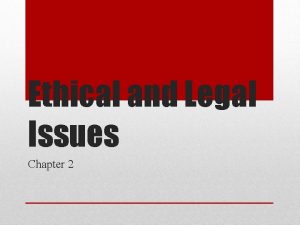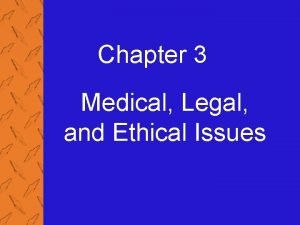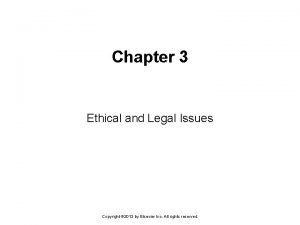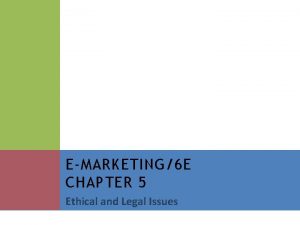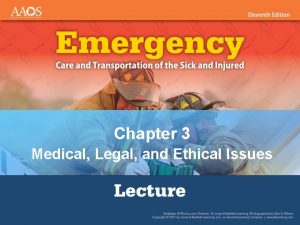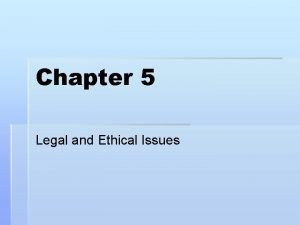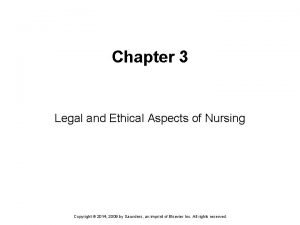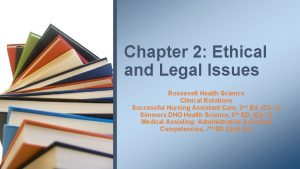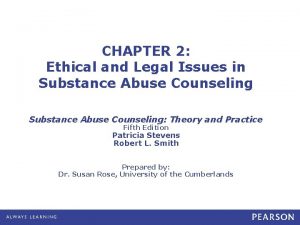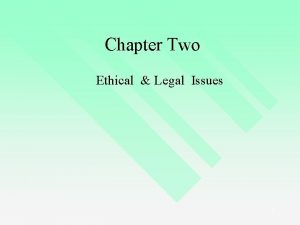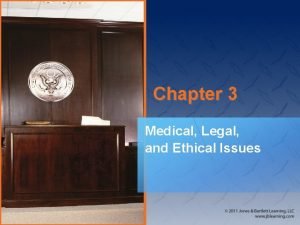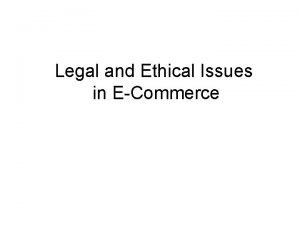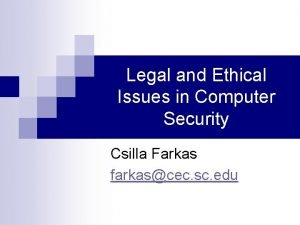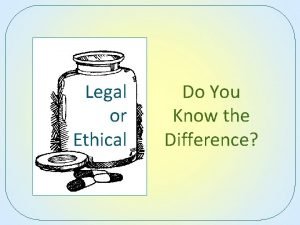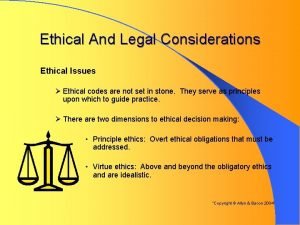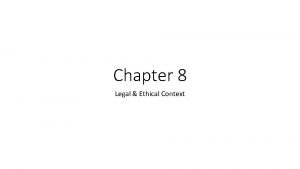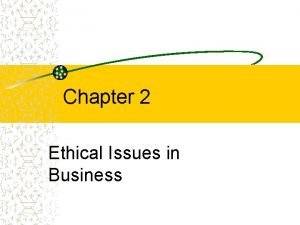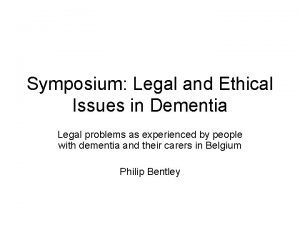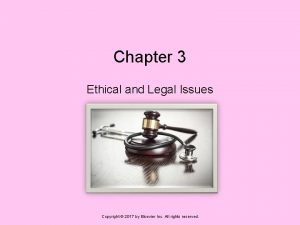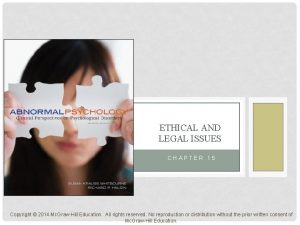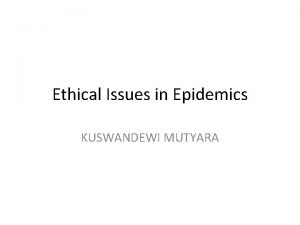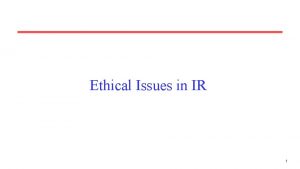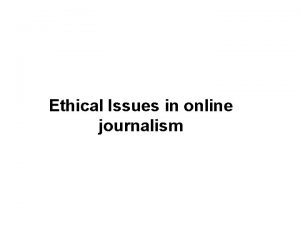Chapter 3 Ethical and Legal Issues Copyright 2013
























- Slides: 24

Chapter 3 Ethical and Legal Issues Copyright © 2013 by Elsevier Inc. All rights reserved.

Learning Objectives 1) 2) 3) State the differences among values, rights, and ethics. Explain the purpose of the Patient Care Partnership. List six steps for making ethical decisions. Copyright © 2013 by Elsevier Inc. All rights reserved. Slide 2

Learning Objectives 4) 5) 6) 7) 8) Identify the legal importance of practice acts. Describe the process of involuntary psychiatric commitment. Name four areas of potential legal liability for mental health care providers. Know the difference between the legal terms negligence and malpractice. Discuss three legal responsibilities that relate to nursing and health care providers. Copyright © 2013 by Elsevier Inc. All rights reserved. Slide 3

Values and Morals (p. 20) Attitudes are ideas that help shape our points of view. Ø Can also describe one’s outlook Belief is a conviction that is intellectually accepted as true whether or not it is based in fact. Value is something that is held dear or a feeling about the worth of an item, idea, or behavior. Ø Formed in childhood Morals reflect one’s attitudes, beliefs, and values. Not easily changed Copyright © 2013 by Elsevier Inc. All rights reserved. Slide 4

Rights (p. 21) A right is described as a power, privilege, or existence to which one has a just claim. Rights help to define social interactions because they contain the principle of justice; they equally and fairly apply to all citizens. Rights also are associated with obligations. Copyright © 2013 by Elsevier Inc. All rights reserved. Slide 5

Client’s Rights (p. 22) The Patient’s Bill of Rights (1972) Ø Ø Ø All clients have the rights to respectful care, privacy, confidentiality, continuity of care, and relevant information. Addresses clients’ rights to Examine their bills Refuse treatment Participate in research The Patient Care Partnership: Understanding Expectations, Rights, and Responsibilities was adopted in 2003. Copyright © 2013 by Elsevier Inc. All rights reserved. Slide 6

Care Provider Rights (p. 22) The rights of nurses and other care providers relate to Ø Ø Ø Respect Safety Competent assistance Care providers have the right to respect as individuals. Nurses have the right to full and equal participation as members of the health care team. All health care providers have the right to set standards for quality and develop policies that affect client care. Copyright © 2013 by Elsevier Inc. All rights reserved. Slide 7

Ethics (p. 22) Ethics is a set of rules or values that govern right behavior. Ethics reflect Values Ø Morals Ø Principles of right and wrong Ø The purpose of ethical behavior is to protect the rights of people Copyright © 2013 by Elsevier Inc. All rights reserved. Slide 8

Ethical Principles (p. 23) Ethical codes serve two purposes: Act as guidelines for standards of practice Ø Let the public know what behaviors can be expected from their health care providers Ø Ethical principles on which codes of ethics are based include the following: Ø Ø Ø Autonomy Beneficence Nonmaleficence Justice Fidelity Veracity Copyright © 2013 by Elsevier Inc. All rights reserved. Slide 9

Codes of Ethics (p. 23) Have been developed by International Council of Nurses Ø American Nurses Association Ø National Federation of Licensed Practical Nurses Ø Canadian Nurses Association Ø Provide information to clients, be truthful, and support your clients, but consult your supervisor if any question of appropriateness arises. Copyright © 2013 by Elsevier Inc. All rights reserved. Slide 10

Ethical Conflict (p. 23) Ethical dilemmas exist when there is uncertainty or disagreement about the moral principles related to a course of action. Ethical dilemmas arise when problems cannot easily be solved by decision making, logic, or use of scientific data. Copyright © 2013 by Elsevier Inc. All rights reserved. Slide 11

Laws and the Legal System (p. 23) Laws are the controls by which a society governs itself. Apply to every member of society Ø Created as a result of • Rules • Regulations • Morals • Ethical principles Ø Copyright © 2013 by Elsevier Inc. All rights reserved. Slide 12

Public vs. Private Law (p. 24) Public law Focuses on the law between government and its citizens Ø Protects the members of society Ø Also known as criminal law Ø Consists of misdemeanors and felonies Ø Private law Focuses on the law between citizens and/or institutions Ø Torts and contracts Ø Also known as civil law Ø Copyright © 2013 by Elsevier Inc. All rights reserved. Slide 13

Legal Concepts in Health Care (p. 25) All health care professions are governed by standards and rules. Nurse practice act Ø Institutional policies Ø Standards of practice Ø Copyright © 2013 by Elsevier Inc. All rights reserved. Slide 14

Laws and Mental Health Care (p. 25) Client-caregiver relationship Caregiver and client enter into an implied contract of acceptance of service. Ø Care providers are legally responsible for their professional obligations and behaviors Ø Copyright © 2013 by Elsevier Inc. All rights reserved. Slide 15

Adult Psychiatric Admissions (pp. 25 -26) When a client initiates the request for mental health services, it is considered a voluntary admission. Ø Voluntarily admitted clients may legally discharge themselves at any time. Involuntary admission is a process for institutionalization initiated by someone other than the client. Involuntary psychiatric admissions provide a protected, therapeutic environment Ø Clients may stay for days to years. Ø Copyright © 2013 by Elsevier Inc. All rights reserved. Slide 16

Areas of Potential Liability (pp. 26 -27) Care providers in mental health are faced with balancing client rights and the need to protect society. The most common crimes in health care settings include homicide, controlled substance violations, and theft. Copyright © 2013 by Elsevier Inc. All rights reserved. Slide 17

Negligence and Malpractice (p. 27) Both negligence and malpractice are rooted in the “reasonable and prudent person” theory. Negligence Ø Omission (or commission) of an act that a reasonable and prudent person would (or would not) do Malpractice Ø Failure to exercise an accepted degree of professional skill that results in injury, loss, or damage Copyright © 2013 by Elsevier Inc. All rights reserved. Slide 18

Responsibility of the Care Provider (pp. 27 -28) Mental health care providers help clients cope with their problems. They provide dignified, humane treatment, which includes protection of rights as human beings, citizens, and clients. Copyright © 2013 by Elsevier Inc. All rights reserved. Slide 19

Question 1 Which of the following is something that is “held dear and represents a feeling about the worth of an item, idea, or behavior”? 1) 2) 3) 4) Attitude Moral Value Belief Copyright © 2013 by Elsevier Inc. All rights reserved. Slide 20

Question 2 The nurse is working in a hospital emergency room. A 55 -year-old female alcoholic, who has been in a car accident, presents to the ER. She is legally intoxicated, and a child in the car that she hit has died. The nurse thinks about the family of the child, and despite her feelings, she decides to take care of the client. This is an example of which stage of value clarification? 1) Choosing 2) Prizing 3) Acting 4) Accepting Copyright © 2013 by Elsevier Inc. All rights reserved. Slide 21

Question 3 Health care practitioners have a legal responsibility to practice in all of the following ways except: 1) 2) 3) 4) In a safe, competent manner With accurate and objective record keeping Within their legal limitations Within a reasonable financial cost Copyright © 2013 by Elsevier Inc. All rights reserved. Slide 22

Question 4 The nurse has a client who always is agitated and tells people she is going to leave the institution. The nurse fails to keep a close watch on this client and fails to notify her supervisor. The client leaves the institution by escaping when no one is watching. This is called: 1) 2) 3) 4) AWOL Autonomy Beneficence Elopement Copyright © 2013 by Elsevier Inc. All rights reserved. Slide 23

Question 5 To be considered negligent, professional misconduct must meet four requirements. Which of the following is not one of the requirements? 1) The care provider owed a duty to the client. 2) The care provider did not carry out the duty. 3) The client was injured as a result of the care provider’s action or inaction. 4) The care provider gained a financial profit. Copyright © 2013 by Elsevier Inc. All rights reserved. Slide 24
 Chapter 2 ethical and legal issues
Chapter 2 ethical and legal issues Medical legal and ethical issues chapter 3
Medical legal and ethical issues chapter 3 Legal and ethical issues chapter 3
Legal and ethical issues chapter 3 Legal and ethical issues chapter 5
Legal and ethical issues chapter 5 Chapter 3 legal and ethical issues
Chapter 3 legal and ethical issues Chapter 6 legal and ethical issues
Chapter 6 legal and ethical issues Legal and ethical issues chapter 5
Legal and ethical issues chapter 5 Nflpn code of ethics
Nflpn code of ethics Chapter 2 ethical and legal issues
Chapter 2 ethical and legal issues Chapter 2 ethical and legal issues
Chapter 2 ethical and legal issues Legal and ethical responsibilities chapter 5
Legal and ethical responsibilities chapter 5 Legal and ethical issues chapter 5
Legal and ethical issues chapter 5 Chapter 2 ethical and legal issues
Chapter 2 ethical and legal issues Chapter 6 legal and ethical issues
Chapter 6 legal and ethical issues Chapter 6 legal and ethical issues
Chapter 6 legal and ethical issues Medical legal and ethical issues chapter 3
Medical legal and ethical issues chapter 3 Resourceful citer
Resourceful citer Ethical and professional issues in information security
Ethical and professional issues in information security Legal and ethical issues in use of ict
Legal and ethical issues in use of ict Legal and ethical issues of e commerce
Legal and ethical issues of e commerce Legal and ethical issues in computer security
Legal and ethical issues in computer security Ethical and legal issues involved in practicum
Ethical and legal issues involved in practicum Ethical issues in computer security
Ethical issues in computer security Ethical and legal issues affecting the nursing assistant
Ethical and legal issues affecting the nursing assistant What is the difference between ethical and legal issues
What is the difference between ethical and legal issues
